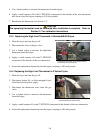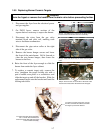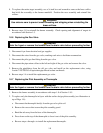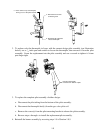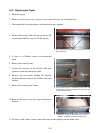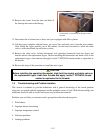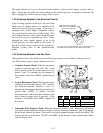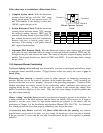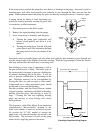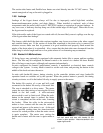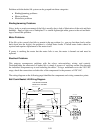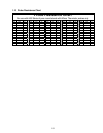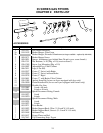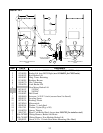
1-14
Follow these steps to troubleshoot a Robertshaw Valve:
1. Complete System check: With the thermostat
contacts closed and gas cock dial “ON”, main
burner should ignite. If not, measure across TP
and TH terminals. If the reading is more than
100 MV, replace the gas valve.
2. System Resistance Check: With the thermostat
contacts closed and main burner “ON”, measure
the millivolt reading between THTP and TH
terminals. Reading should be less than 80MV. If
not, recheck thermostat leads and connections.
Replace with new or heavier gauge wires if
necessary. If the reading is still greater than 80
MV, replace the thermostat.
Millivolt Operator Terminal
Panel
Terminal 1
Terminal 2
Terminal 3
TH
TP
TH
TP
Test
Meter
Setting
Meter Leads
on Terminals
Acceptable
Results
1 MV TP TH Less than 100MV
2 MV THTP TH Less than 80MV
3 MV THTP TP 120-30MV
3. Automatic Pilot Dropout Check: With the thermostat contacts open, depress gas cock knob
with pilot lit until maximum millivolt output is observed between terminals THTP and TP.
Extinguish the pilot and observe the meter. The sound of the pilot magnet dropping should be
audible. The dropout should occur between 120MV and 30MV. If outside these limits, change
the gas valve.
1.9.5 Improper Burner Functioning
The burner lighting on one side only may be caused by a missing or misaligned rear deflector target
or improper burner manifold pressure. Clogged burner orifices are usually the cause of gaps in
burner firing.
Fluctuating flame intensity is normally caused by either improper or fluctuating incoming gas
pressure, but may also be the result of variations in the kitchen atmosphere. Verify incoming gas
pressure in the same way as for “popping,” discussed in the preceding paragraphs. Variations in the
kitchen atmosphere are usually caused by air conditioning and/or ventilation units starting and
stopping during the day. As they start and stop, the pressure in the kitchen may change from
positive or neutral to negative, or vice versa. They may also cause changes in airflow patterns that
may affect flame intensity.
Flames “rolling” out of the fryer are usually an indication of negative pressure in the kitchen. Air
is being sucked out of the fryer enclosure and the flames are literally following the air. If negative
pressure is not the cause, check for high burner manifold gas pressure in accordance with the
procedures in Chapter 5 of the Installation and Operation Manual (P/N 819-5776). An obstructed
flue, which prevents the fryer from properly exhausting, may also be the cause.
An excessively noisy burner, especially with flames visible above the flue opening, may indicate
that the burner gas pressure is too high, or it may simply be that the gas valve vent tube is blocked.
If the gas pressure is correct and the vent tube in unobstructed, the gas valve regulator is probably
defective.



